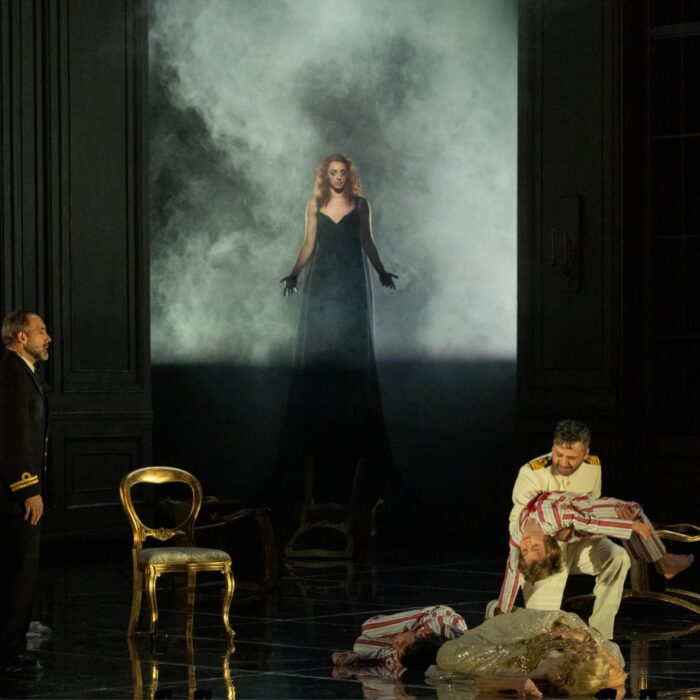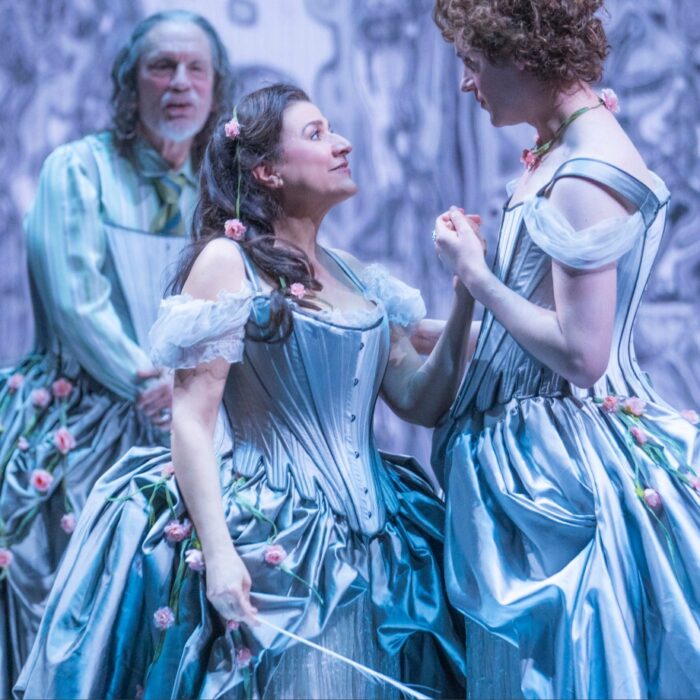
CD Review: Il Proscritto
By Bob DieschburgScotland, near Edinburgh: Malvina Douglas, while still in mourning, is set to marry Arturo Murray, a staunch Cromwellian and political adversary to her purportedly dead first husband, Giorgio Argyll.
Yet at the very height of the celebration, the latter storms in and, to the utmost horror of the bride – who is the only one to recognize him – is taken prisoner by the ominous Guglielmo Ruthven. Malvina pleads for his release, not revealing the stranger’s identity; it only becomes known when Arturo catches them plotting an escape and Giorgio, to defend Malvina’s honor, agrees to die for her love.
But as his self-sacrifice builds and Arturo even volunteers to set him free, Malvina’s inner conflict supersedes their rivalry. Oscillating between her love for Giorgio and the newly gained affection for her now-husband Arturo, she poisons herself and, cathartically, entreats them to stay true to her dying wish, that is to consent to live (“Per sempre, allor viver consenti?”).
Thus reads, grosso modo, the storyline of Saverio Mercadante’s “Il Proscritto” from 1842 which the combined forces of Opera Rara and Britten Sinfonia, for the first time ever, revive in a stunningly produced recording with a luxurious cast of soloists.
All British Doom & Gloom
Steeped in the early 19th century’s fascination for the exoticism of historical Britain, “Il Proscritto” is based on a French drama of the same title by Frédéric Soulié and Timothée Dehay. It had been turned into a libretto and, subsequently, an opera at least two times before Salvadore Cammarano (known mostly as the librettist of Verdi and Donizetti) started work on the subject, reducing the play’s action from five acts to only three.
On a side note, it is interesting to view “Il Proscritto” within the larger context of Cammarano’s interpretation of British lore, recurrent, for instance, in his libretti to “Lucia di Lammermoor” (1835), “Roberto Devereux” (1837), and, in 1843, “Il Reggente.” There is, in the eyes of who currently writes, a tendency towards historical eclecticism not unlike Luigi Illica’s (in “Andrea Chenier”) when evoking Cromwell and his political strife with the royalists in 17th century Scotland.
It no doubt reinforces the density of the narrative while providing clues to Mercadante setting the atmosphere to his melodramma tragico in three acts.
Between Reform & Romanticism
Musically, “Il Proscritto” is to be situated halfway between the Romantic tradition and the modernism, so to speak, of Verdi’s “Macbeth” (1847). Free, for the most part, from the Bellinian flourish, it nevertheless sticks to the formal constituents of the Belcanto norm, including the reliance on cabalettas and various ornaments, as well as two magnificent concertati at the ends of acts 1 and 2.
Roger Parker, in the booklet’s excellent introductory essay, describes its hybrid position in much greater detail than would fit the scope of the present review – suffice to say, “Il Proscritto” comes at a crucial point in Mercadante’s career when, as the Director of the Naples Conservatory, he seems to reflect on his own program for operatic reform matured, as it is, in the wake of his attending the premiere of Meyerbeer’s “Les Huguenots” in Paris in 1836.
A Tenor Standoff
With their new release, Opera Rara delivers a near-perfect rendition of “Il Proscritto.” Carlo Rizzi, at the helm of the orchestral forces of Britten Sinfonia, conducts with verve and dramatic intuition, yet also with a keen sense for the score’s more descriptive passages, such as when the horns give an air of foreboding to Giorgio’s romanza “L’aura ch’io spiro” and the subsequent finale of Act one.
Ramón Vargas, long established as one of the leading tenors of his generation, gives a wonderfully subtle portrayal of Giorgio Argyll. He is sensitive to the role’s lyrical moments as much as to its dramatic demands, as in the confrontation scene with Arturo in Act two or towards the very end of the opera when the musical writing increasingly supports a somewhat declamatory style.
The latter is mastered equally well by Iván Ayón-Rivas, winner of the 2021 edition of the Operalia competition in Moscow. His Arturo has all the warmth of a true Romantic, the tone flowing freely and extending towards the top without any noticeable retraction in terms of vocal production.
Like his Mexican colleague, Ayón-Rivas demonstrates first-rate dramatic instinct, as in the form known as tempo di mezzo for its relatively fast back-and-forth between, in this case, Arturo and Malvina.
The only qualm I may tentatively raise (and it is independent from their qualities as artists) concerns the vocal timbre of the tenors which, both in terms of sound and expression, is so similar as to tendentially confuse, in the ensemble scenes, who is singing.
DeShong in the Limelight
In Irene Roberts they find an excellent Malvina whose lean but no less honeyed mezzo imbues the character with uncommon liveliness. This holds true despite the notable absence of an aria or melodic tune tailored to the vocal physiognomy of the love-torn bride.
A revelation in its own, however, is the seemingly infinite artistry of Elizabeth DeShong. As Odoardo, a magnificently written trouser-role, she stands in the musical limelight from beginning to end, stunning with the velvety depth of her alto tones while blazing through the coloraturas of the second-act cabaletta “Colui che m’ha quest’anima.”
It is a tour de force for sure, but one tackled with technical bravura and interpretive intelligence, adding to the extreme care with which Opera Rara thankfully resuscitated “Il Proscritto” from the archives of the Naples Conservatory.
For in addition to its many musical delights, it strikingly bridges the gap between early 19th century Romanticism and the search for new means of dramatic expression in the interim years between the death of Bellini and Verdi reaching maturity.


